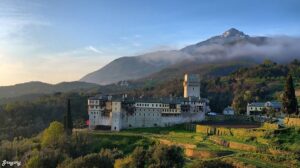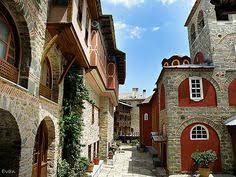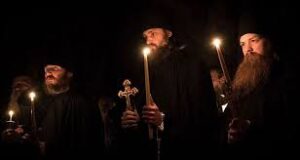At Last: To the Holy Mountain!
If you’d like to prepare a bit more before we leave for Mount Athos in the morning, here is the second part of the CBS program on the Holy Mountain.
On Wednesday morning, after a restless night’s sleep fearing I wouldn’t wake up at 4 a.m., it was off very early to Mount Athos.
The Holy Mountain. Where to begin? For one thing, it’s hard to get there, intentionally so. There are no roads onto Mount Athos. What is required is a two hour bus ride east to Ouranopolis, then two more hours by boat to Daphne, the port of Athos. Soon after Ouranopolis “civilization” ends (or perhaps it truly begins?), and the shore becomes wild forest interrupted only by the occasional monastery. Then comes a scary bus ride over switchbacks about 2000 feet up the face of a cliff on an unimproved road to Karyes the capitol of Athos, and finally (for me) thirty minutes farther in a van driven very fast by a lunatic driver, a mad monk, over a primitive mountain road to Karakallou Monastery. Not long ago the only way in was on foot.
Visitors on the Holy Mountain normally stay only one nigh t in each monastery, then must move to another. Somehow Father Barnabas got me permission to stay three days at Karakallou, so I could get a better sense of the community and spend more time with him. Karakallou’
t in each monastery, then must move to another. Somehow Father Barnabas got me permission to stay three days at Karakallou, so I could get a better sense of the community and spend more time with him. Karakallou’ s setting is gorgeous. Unlike the austere scenery of southern Greece, the area is densely wooded, on a slope with the blue Aegean Sea perhaps 500 feet below on the east and the 6500 foot Mount Athos hanging over it to the west.
s setting is gorgeous. Unlike the austere scenery of southern Greece, the area is densely wooded, on a slope with the blue Aegean Sea perhaps 500 feet below on the east and the 6500 foot Mount Athos hanging over it to the west.
When we arrived, we guests were greeted in the traditional way with a glass of water, some loukoumi (Turkish delight, but don’t tell the Greeks), and a little glass of ouzo (licorice-flavored liquor). After the van ride, I definitely needed that!
And there was Father Barnabas, barely recognizable to me with his long white beard, who said he was happy and doing well and sent his love to all at home. He said he offered a round of Jesus Prayers  for us at Saint Nicholas every day. One day he showed me the ossuary where the skulls and bones of monks from many hundreds of years are stacked on shelves,
for us at Saint Nicholas every day. One day he showed me the ossuary where the skulls and bones of monks from many hundreds of years are stacked on shelves,
awaiting the general Resurrection. He said, “That is where my bones will lie” – as now they do. May his memory be eternal.
After I kissed the abbot’s hand, he kissed mine, which I took as a warm welcome, since I was told he was quite suspicious of us “modernist” priests with short hair and short beards. Athos also is having a spiritual revival in nearly all the great monasteries and cells and sketes up and down the peninsula, with many young well-educated novices and monks. Thirty years ago Karakallou had about eight monks; today there are about fifty. There are many pilgrims. The boats I took to and from Mount Athos were standing room only. Since I was there, the Athonite government has put more limits on visitors, lest the essential life of the Holy Mountain be disturbed by its popularity.
A sense of holy peace pervades the place. The feel of it, especially at night, keeps coming back to me: the deep silence with only a barely audible “whssh… whssh” from the sea, and the brilliance of the stars. The moon was full while I was there and the weather clear, and at night the sea and the landscape shimmering and Mount Athos almost luminous in the moonlight. Then came the semantron * echoing through the monastic enclosure calling us to worship, and finally the majestic ringing of the bells. It gave me the holy chills. It still does. It was ethereally beautiful.
(* The rhythmic clacking of wood planks which you can hear on Blog # 1. The origin of the semantron is obscure, but it goes way back in Eastern Church history and perhaps became more popular during the time when the Turks forbade church bells.
Unexpected Contrasts
I guess I assumed the place would be dank and dark and kind of spooky. Instead Karakallou was immaculately kept and spotlessly clean. Conservation and protection of the Athonite monasteries are subsidized by the Greek government, and also by the EU (European Union) as part of Europe’s cultural heritage. That explains the fireplugs beside the roads and the new reservoirs in case of forest fire. How odd that the secular EU can support religious institutions, while the US government cannot.
 We guests stayed in a 500-year-old building (to the left) with a cheery interior, good modern western European plumbing (as opposed to the usual Greek toilet plumbing which is best left undescribed) and central heating and screens on the windows, the last things I expected in Greece, let alone on Athos. However personal washing facilities are primitive with hot water only two days a week. The third day on Athos I tried to find a mirror. There are no mirrors! You get the point: one is to be concerned only with the interior life.
We guests stayed in a 500-year-old building (to the left) with a cheery interior, good modern western European plumbing (as opposed to the usual Greek toilet plumbing which is best left undescribed) and central heating and screens on the windows, the last things I expected in Greece, let alone on Athos. However personal washing facilities are primitive with hot water only two days a week. The third day on Athos I tried to find a mirror. There are no mirrors! You get the point: one is to be concerned only with the interior life.
There is electricity everywhere except in the church; nevertheless, cooking is done on ancient wooden stoves. Though they find snacks for visitors, the regular monastic food was what I called “medieval Greek peasant fare”. After I left, Father Barnabas told Father Alexis, a young monk from Dover, Delaware, how I had described the food. Father Alexis responded, “He’s too kind.” On Mondays, Wednesdays and Fridays, they keep a strict Great-Lenten fast with an excess of beans. They never have meat, and fish only on major holy days. I know this because in preparation for a holy day I helped Father Barnabas, who worked in the kitchen, clean many many little fishes by hand, after which I reeked for a  week.
week.
(This is the interior of the monastery with monastic cells on the left, the catholikon [church] on the right. I wish I could show you the inside of the church, but no photographs are permitted.)
But there was a modern card phone right outside the monastery. I put in the card, pressed 13 numbers and Khouria Dianna said “hello”, sounding as if she were standing beside me. On the boat coming in I was watching a very ascetic-looking old monk who seemed lost in prayer, when suddenly he pulled out a mobile phone and began an animated conversation! The feel of ancient Byzantium permeates the place, and life is lived on “Byzantine time” with the hours beginning at sunset. The church was lighted only by candles, and the services have changed scarcely a syllable  or a ceremony in over a thousand years. On the other hand, Father Barnabas said he needed a new laptop computer, since he had nearly worn out his old MAC.
or a ceremony in over a thousand years. On the other hand, Father Barnabas said he needed a new laptop computer, since he had nearly worn out his old MAC.
You put all this together. I don’t think I can!
Next time: More about Mount Athos
as always, I really enjoyed reading this and your descriptions! thank you!